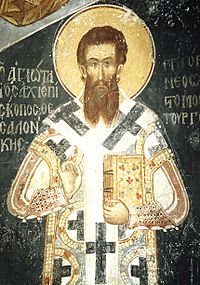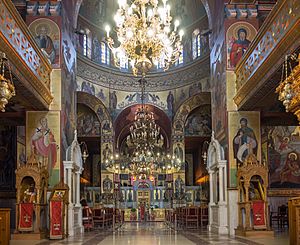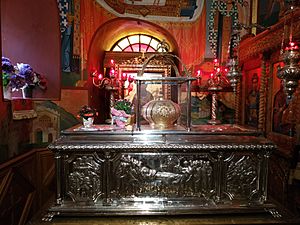Gregory Palamas facts for kids
Quick facts for kids SaintGregory Palamas |
|
|---|---|

Painting of Saint Gregory in Monastery of Vatopaidi, Mount Athos, Greece. The captions call him, among other titles, Νέος Χρυσόστομος: A New Chrysostom.
|
|
| Archbishop of Thessalonica, Church Father, Pillar of Orthodoxy | |
| Born | 1296 Constantinople, (modern-day Istanbul, Turkey) |
| Died | 14 November 1357 (aged 60-61) Thessaloniki, Macedonia (modern-day Greece) |
| Venerated in | Eastern Orthodox Church Eastern Catholic Churches Anglican Communion |
| Canonized | 1368, Constantinople by Patriarch Philotheos of Constantinople |
| Major shrine | Thessaloniki |
| Feast | 14 November, Second Sunday of Great Lent |
| Attributes | Long, tapering dark beard, vestments of a bishop, Gospel Book or scroll, right hand raised in benediction |
| Influenced | Nilus Cabasilas, Gennadius Scholarius, Nicodemus the Hagiorite, Sophrony of Essex, John Meyendorff, Seraphim Rose |
Gregory Palamas (born around 1296, died 1359) was an important Byzantine Greek thinker and Eastern Orthodox church leader. He was a monk on Mount Athos in modern Greece. Later, he became the archbishop of Thessaloniki.
Gregory is well-known for defending a special way of prayer called hesychast spirituality. This practice involves quiet prayer and focusing on God. He also taught about the special light seen during the Transfiguration of Jesus. He explained that God's true nature (essence) is different from how God acts in the world (energies).
His ideas led to three big discussions with other thinkers between 1336 and 1355. His teachings are sometimes called Palamism. People who followed his ideas are known as Palamites.
The Eastern Orthodox Church has honored Gregory as a saint since 1368. Some people in the Catholic Church also see him as a saint. Pope John Paul II called Gregory a great religious writer. Since 1971, the Melkite Greek Catholic Church has also honored him. Many of his writings are in a collection called the Philokalia. The second Sunday of Great Lent is a special day to remember Saint Gregory Palamas in the Orthodox Church.
Contents
Early Life and Education
Gregory was born in Constantinople around the year 1296. This city is now called Istanbul in Turkey. His father, Constantine, worked for the Byzantine Emperor Andronikos II Palaiologos. Sadly, Gregory's father died when Gregory was still young.
The Emperor himself helped raise and educate Gregory. He hoped that Gregory, who was very smart, would work for the government. However, Gregory chose a different path. He decided to become a monk on Mount Athos. Gregory's mother and his brothers and sisters also became monks or nuns. The whole family was recognized as saints in 2009.
Before going to Mount Athos, Gregory received a good education at the University of Constantinople. He studied many subjects, including the ideas of the ancient Greek philosopher Aristotle.
Becoming a Monk
Even though the Emperor wanted him to work in government, Gregory chose a religious life. When he was just 21 years old, in 1316, he went to Mount Athos. There, he became a beginner monk at the Vatopedi monastery. He learned from an experienced monk named St Nicodemos.
Later, Gregory became a full monk and continued his strict religious life. After Nicodemos died, Gregory spent eight more years learning from another elder monk, Nicephorus. After Nicephorus also passed away, Gregory moved to the Great Lavra monastery on Mount Athos. He helped the other monks there by serving food and singing in church.
Gregory wanted to spend even more time in prayer. So, he moved to a smaller place called Glossia. There, he taught an old way of prayer known as "prayer of the heart" or hesychasm. This type of prayer focuses on inner quiet and connection with God.
In 1326, because of dangers from Turkish invasions, Gregory and the other monks moved to the city of Thessaloniki. There, he became a priest. He divided his time between helping the people and trying to achieve spiritual perfection. He started a small group of hermits (people who live alone for religious reasons) near Thessaloniki.
For a short time, he was the head of the Esphigmenou Monastery. But he had to leave in 1335. This was because some monks were unhappy with how strict his rules were.
Later Years and Challenges
Gregory faced many challenges. People who disagreed with his teachings spread false stories about him. In 1344, the church leader Patriarch John XIV had him put in prison for four years.
However, in 1347, a new Patriarch named Isidore became the head of the church. Gregory was then released from prison. He was made the Metropolitan of Thessalonica, a high church position. But the people of Thessaloniki did not accept him at first because the arguments about his teachings were still going on. So, he had to live in different places. It was not until 1350 that he could finally take his place as archbishop in Thessaloniki.
In 1354, while traveling to Constantinople, his ship was captured by Turkish pirates. He was taken prisoner and beaten. He had to spend a year held by the Ottoman court, but he was treated well there. Eventually, a payment was made to free him. He then returned to Thessaloniki. He served as archbishop for the last three years of his life.
Death and Canonization
Gregory Palamas died in 1357 or 1359. His last words were, "To the heights! To the heights!"
He was declared a saint of the Eastern Orthodox Church in 1368. This was done by Patriarch Philotheos of Constantinople. Philotheos also wrote a book about Gregory's life and created the church service honoring him.
His feast day is celebrated twice a year. One day is 14 November, which is the anniversary of his death. The other is the Second Sunday of Great Lent. This is because Gregory's victory in the debates is seen as a continuation of the Triumph of Orthodoxy. This is a celebration of the Church's victory over false teachings, which is celebrated the Sunday before.
Gregory's holy remains are kept in the Church of Saint Gregory Palamas in Thessaloniki.
Hymns Honoring Saint Gregory
These are some of the hymns sung in honor of Saint Gregory Palamas:
- Troparion (Tone 8)
- O light of Orthodoxy, teacher of the Church, its confirmation,
- O ideal of monks and invincible champion of theologians,
- O wonder-working Gregory, glory of Thessaloniki and preacher of grace,
- always intercede before the Lord that our souls may be saved.
- Kontakion (Tone 8)
- Holy and divine instrument of wisdom,
- joyful trumpet of theology,
- together we sing your praises, O God-inspired Gregory.
- Since you now stand before the Original Mind, guide our minds to Him, O Father,
- so that we may sing to you: "Rejoice, preacher of grace."
Writings of Saint Gregory
Saint Gregory Palamas wrote many important texts. Some of his works are collected in the Philokalia.
Here are some of his main works that have been translated into English:
- The Triads
- Saint Gregory Palamas: The Homilies (a collection of his sermons)
- Treatise on the Spiritual Life
- The One Hundred and Fifty Chapters
See also
 In Spanish: Gregorio Palamás para niños
In Spanish: Gregorio Palamás para niños
- Tabor Light
- Mount Athos
- Christian mysticism



